Report on Developing Individuals: Skills, Training, and Performance
VerifiedAdded on 2020/09/03
|15
|4126
|77
Report
AI Summary
This report provides a comprehensive analysis of individual development within an organization, focusing on the crucial role of Human Resources in fostering employee skills, knowledge, and behavior. It examines the importance of identifying employee needs through skill audits and creating professional development plans. The report contrasts individual and organizational learning, highlighting their interconnectedness and impact on sustainable performance. It also explores the contributions of high-performance working to employee engagement and competitive advantage, concluding with a discussion on the significance of effective performance management strategies. The report uses the case study of Jane Cambridge, a Human Resource Officer, to illustrate the practical application of these concepts, emphasizing the need for continuous learning and development to meet the evolving demands of the workplace. The report also details the skills required by HR professionals, including communication, negotiation, policy execution, and understanding individual behavior.
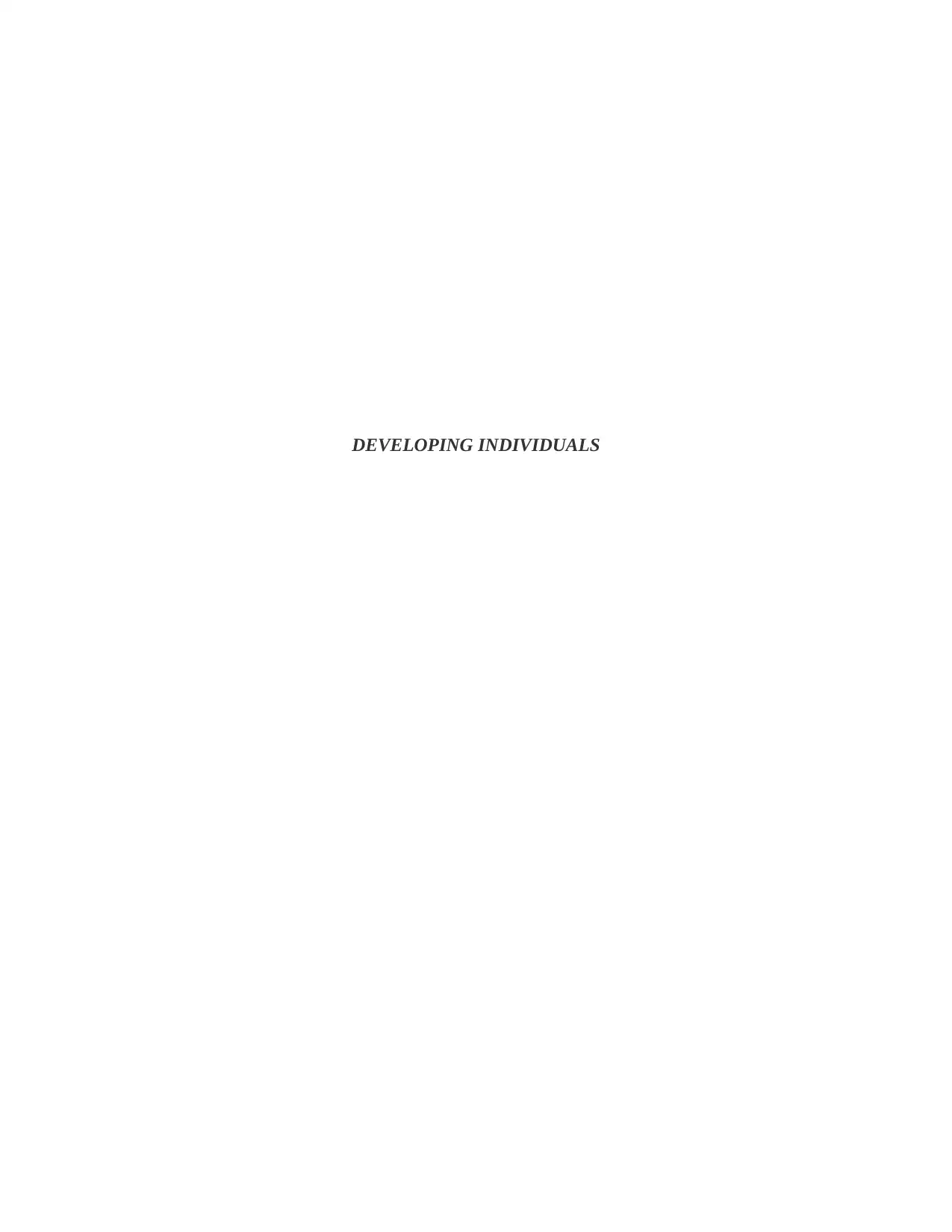
DEVELOPING INDIVIDUALS
Paraphrase This Document
Need a fresh take? Get an instant paraphrase of this document with our AI Paraphraser
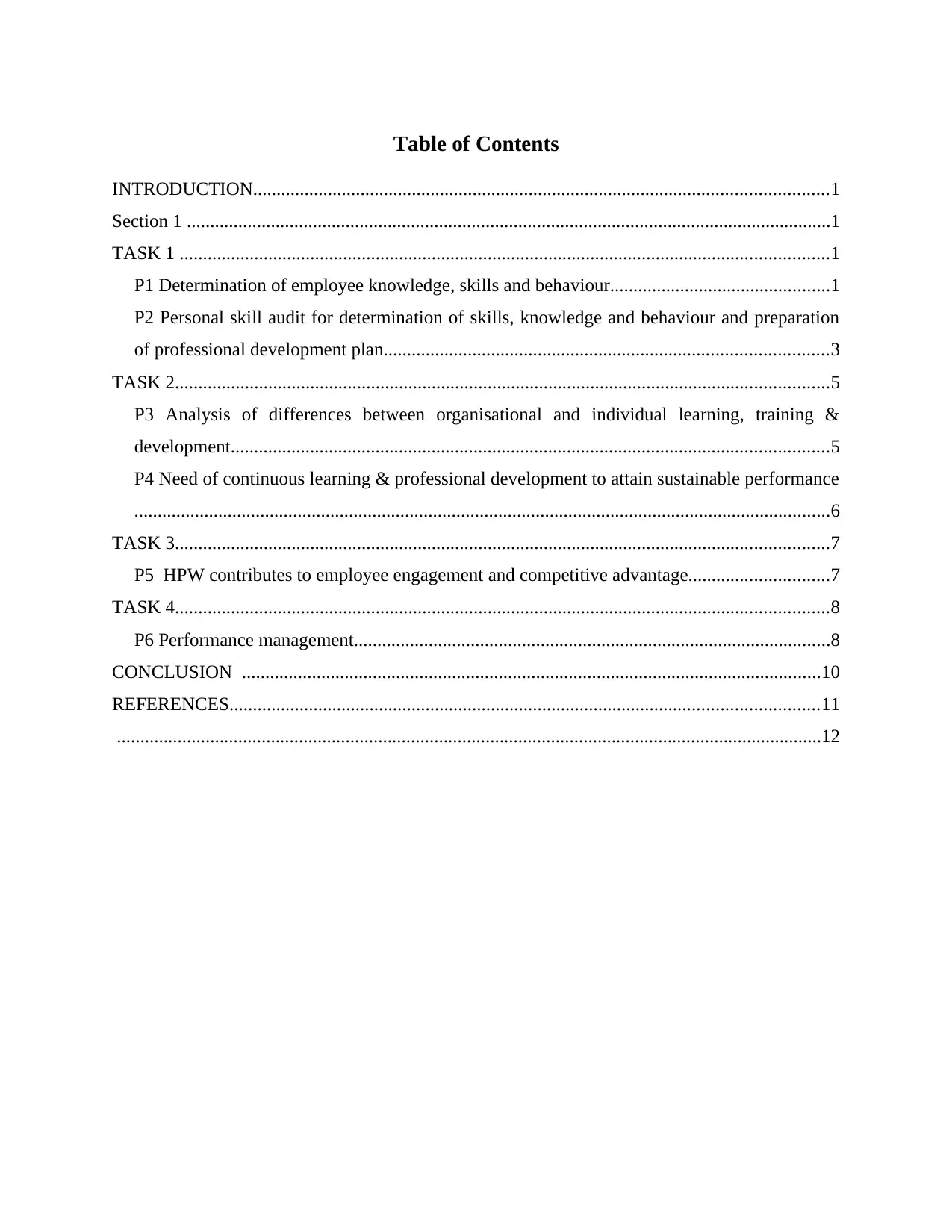
Table of Contents
INTRODUCTION...........................................................................................................................1
Section 1 ..........................................................................................................................................1
TASK 1 ...........................................................................................................................................1
P1 Determination of employee knowledge, skills and behaviour...............................................1
P2 Personal skill audit for determination of skills, knowledge and behaviour and preparation
of professional development plan...............................................................................................3
TASK 2............................................................................................................................................5
P3 Analysis of differences between organisational and individual learning, training &
development................................................................................................................................5
P4 Need of continuous learning & professional development to attain sustainable performance
.....................................................................................................................................................6
TASK 3............................................................................................................................................7
P5 HPW contributes to employee engagement and competitive advantage..............................7
TASK 4............................................................................................................................................8
P6 Performance management......................................................................................................8
CONCLUSION ............................................................................................................................10
REFERENCES..............................................................................................................................11
.......................................................................................................................................................12
INTRODUCTION...........................................................................................................................1
Section 1 ..........................................................................................................................................1
TASK 1 ...........................................................................................................................................1
P1 Determination of employee knowledge, skills and behaviour...............................................1
P2 Personal skill audit for determination of skills, knowledge and behaviour and preparation
of professional development plan...............................................................................................3
TASK 2............................................................................................................................................5
P3 Analysis of differences between organisational and individual learning, training &
development................................................................................................................................5
P4 Need of continuous learning & professional development to attain sustainable performance
.....................................................................................................................................................6
TASK 3............................................................................................................................................7
P5 HPW contributes to employee engagement and competitive advantage..............................7
TASK 4............................................................................................................................................8
P6 Performance management......................................................................................................8
CONCLUSION ............................................................................................................................10
REFERENCES..............................................................................................................................11
.......................................................................................................................................................12

⊘ This is a preview!⊘
Do you want full access?
Subscribe today to unlock all pages.

Trusted by 1+ million students worldwide
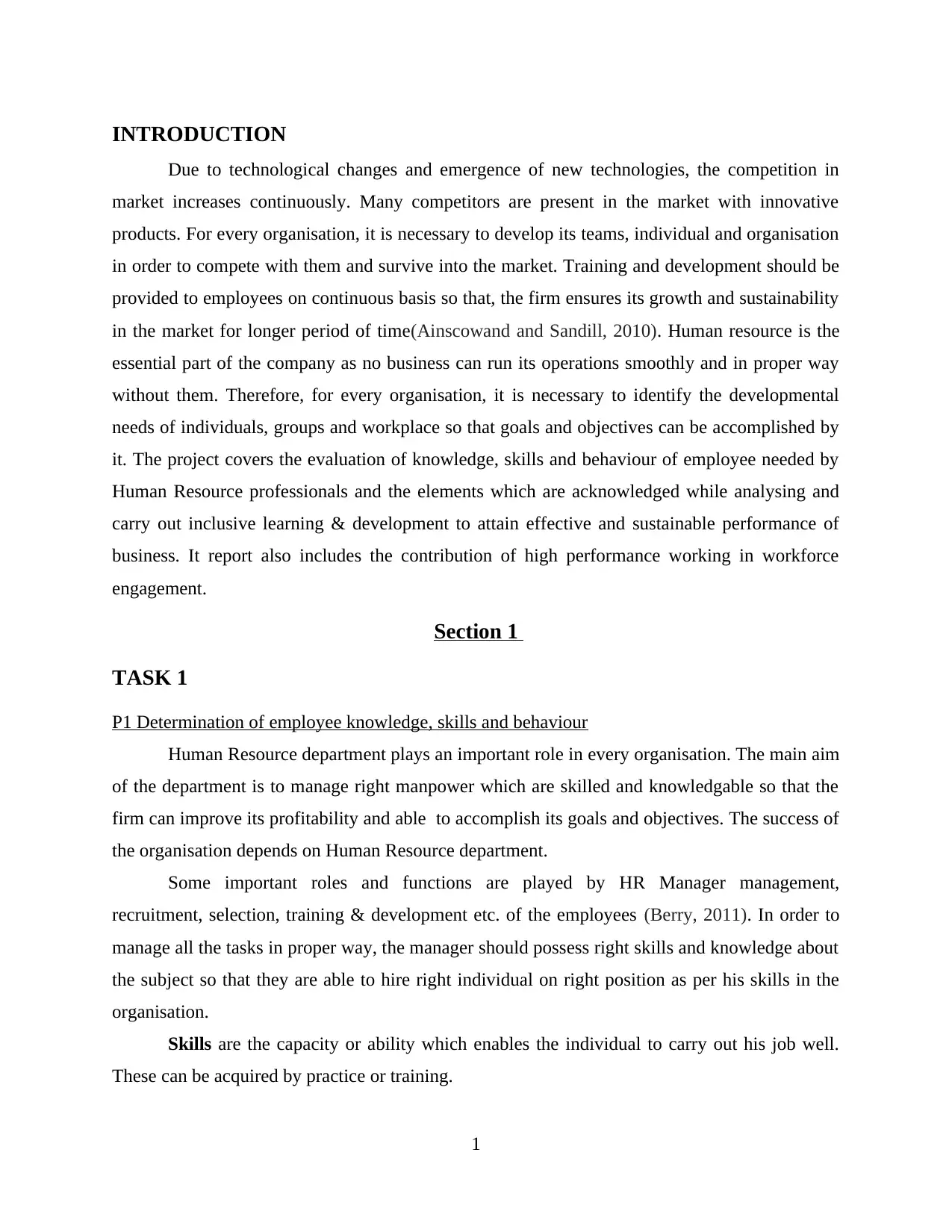
INTRODUCTION
Due to technological changes and emergence of new technologies, the competition in
market increases continuously. Many competitors are present in the market with innovative
products. For every organisation, it is necessary to develop its teams, individual and organisation
in order to compete with them and survive into the market. Training and development should be
provided to employees on continuous basis so that, the firm ensures its growth and sustainability
in the market for longer period of time(Ainscowand and Sandill, 2010). Human resource is the
essential part of the company as no business can run its operations smoothly and in proper way
without them. Therefore, for every organisation, it is necessary to identify the developmental
needs of individuals, groups and workplace so that goals and objectives can be accomplished by
it. The project covers the evaluation of knowledge, skills and behaviour of employee needed by
Human Resource professionals and the elements which are acknowledged while analysing and
carry out inclusive learning & development to attain effective and sustainable performance of
business. It report also includes the contribution of high performance working in workforce
engagement.
Section 1
TASK 1
P1 Determination of employee knowledge, skills and behaviour
Human Resource department plays an important role in every organisation. The main aim
of the department is to manage right manpower which are skilled and knowledgable so that the
firm can improve its profitability and able to accomplish its goals and objectives. The success of
the organisation depends on Human Resource department.
Some important roles and functions are played by HR Manager management,
recruitment, selection, training & development etc. of the employees (Berry, 2011). In order to
manage all the tasks in proper way, the manager should possess right skills and knowledge about
the subject so that they are able to hire right individual on right position as per his skills in the
organisation.
Skills are the capacity or ability which enables the individual to carry out his job well.
These can be acquired by practice or training.
1
Due to technological changes and emergence of new technologies, the competition in
market increases continuously. Many competitors are present in the market with innovative
products. For every organisation, it is necessary to develop its teams, individual and organisation
in order to compete with them and survive into the market. Training and development should be
provided to employees on continuous basis so that, the firm ensures its growth and sustainability
in the market for longer period of time(Ainscowand and Sandill, 2010). Human resource is the
essential part of the company as no business can run its operations smoothly and in proper way
without them. Therefore, for every organisation, it is necessary to identify the developmental
needs of individuals, groups and workplace so that goals and objectives can be accomplished by
it. The project covers the evaluation of knowledge, skills and behaviour of employee needed by
Human Resource professionals and the elements which are acknowledged while analysing and
carry out inclusive learning & development to attain effective and sustainable performance of
business. It report also includes the contribution of high performance working in workforce
engagement.
Section 1
TASK 1
P1 Determination of employee knowledge, skills and behaviour
Human Resource department plays an important role in every organisation. The main aim
of the department is to manage right manpower which are skilled and knowledgable so that the
firm can improve its profitability and able to accomplish its goals and objectives. The success of
the organisation depends on Human Resource department.
Some important roles and functions are played by HR Manager management,
recruitment, selection, training & development etc. of the employees (Berry, 2011). In order to
manage all the tasks in proper way, the manager should possess right skills and knowledge about
the subject so that they are able to hire right individual on right position as per his skills in the
organisation.
Skills are the capacity or ability which enables the individual to carry out his job well.
These can be acquired by practice or training.
1
Paraphrase This Document
Need a fresh take? Get an instant paraphrase of this document with our AI Paraphraser
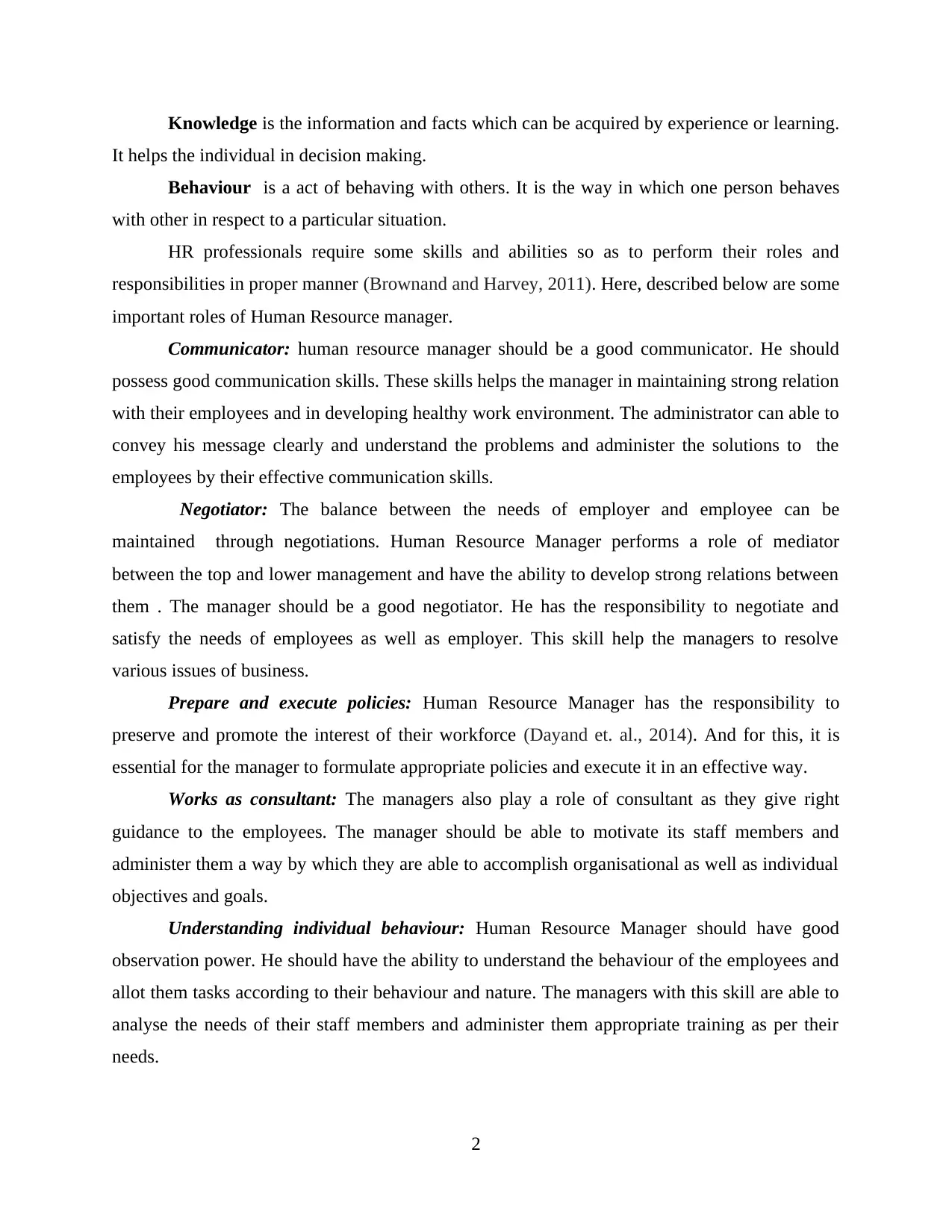
Knowledge is the information and facts which can be acquired by experience or learning.
It helps the individual in decision making.
Behaviour is a act of behaving with others. It is the way in which one person behaves
with other in respect to a particular situation.
HR professionals require some skills and abilities so as to perform their roles and
responsibilities in proper manner (Brownand and Harvey, 2011). Here, described below are some
important roles of Human Resource manager.
Communicator: human resource manager should be a good communicator. He should
possess good communication skills. These skills helps the manager in maintaining strong relation
with their employees and in developing healthy work environment. The administrator can able to
convey his message clearly and understand the problems and administer the solutions to the
employees by their effective communication skills.
Negotiator: The balance between the needs of employer and employee can be
maintained through negotiations. Human Resource Manager performs a role of mediator
between the top and lower management and have the ability to develop strong relations between
them . The manager should be a good negotiator. He has the responsibility to negotiate and
satisfy the needs of employees as well as employer. This skill help the managers to resolve
various issues of business.
Prepare and execute policies: Human Resource Manager has the responsibility to
preserve and promote the interest of their workforce (Dayand et. al., 2014). And for this, it is
essential for the manager to formulate appropriate policies and execute it in an effective way.
Works as consultant: The managers also play a role of consultant as they give right
guidance to the employees. The manager should be able to motivate its staff members and
administer them a way by which they are able to accomplish organisational as well as individual
objectives and goals.
Understanding individual behaviour: Human Resource Manager should have good
observation power. He should have the ability to understand the behaviour of the employees and
allot them tasks according to their behaviour and nature. The managers with this skill are able to
analyse the needs of their staff members and administer them appropriate training as per their
needs.
2
It helps the individual in decision making.
Behaviour is a act of behaving with others. It is the way in which one person behaves
with other in respect to a particular situation.
HR professionals require some skills and abilities so as to perform their roles and
responsibilities in proper manner (Brownand and Harvey, 2011). Here, described below are some
important roles of Human Resource manager.
Communicator: human resource manager should be a good communicator. He should
possess good communication skills. These skills helps the manager in maintaining strong relation
with their employees and in developing healthy work environment. The administrator can able to
convey his message clearly and understand the problems and administer the solutions to the
employees by their effective communication skills.
Negotiator: The balance between the needs of employer and employee can be
maintained through negotiations. Human Resource Manager performs a role of mediator
between the top and lower management and have the ability to develop strong relations between
them . The manager should be a good negotiator. He has the responsibility to negotiate and
satisfy the needs of employees as well as employer. This skill help the managers to resolve
various issues of business.
Prepare and execute policies: Human Resource Manager has the responsibility to
preserve and promote the interest of their workforce (Dayand et. al., 2014). And for this, it is
essential for the manager to formulate appropriate policies and execute it in an effective way.
Works as consultant: The managers also play a role of consultant as they give right
guidance to the employees. The manager should be able to motivate its staff members and
administer them a way by which they are able to accomplish organisational as well as individual
objectives and goals.
Understanding individual behaviour: Human Resource Manager should have good
observation power. He should have the ability to understand the behaviour of the employees and
allot them tasks according to their behaviour and nature. The managers with this skill are able to
analyse the needs of their staff members and administer them appropriate training as per their
needs.
2
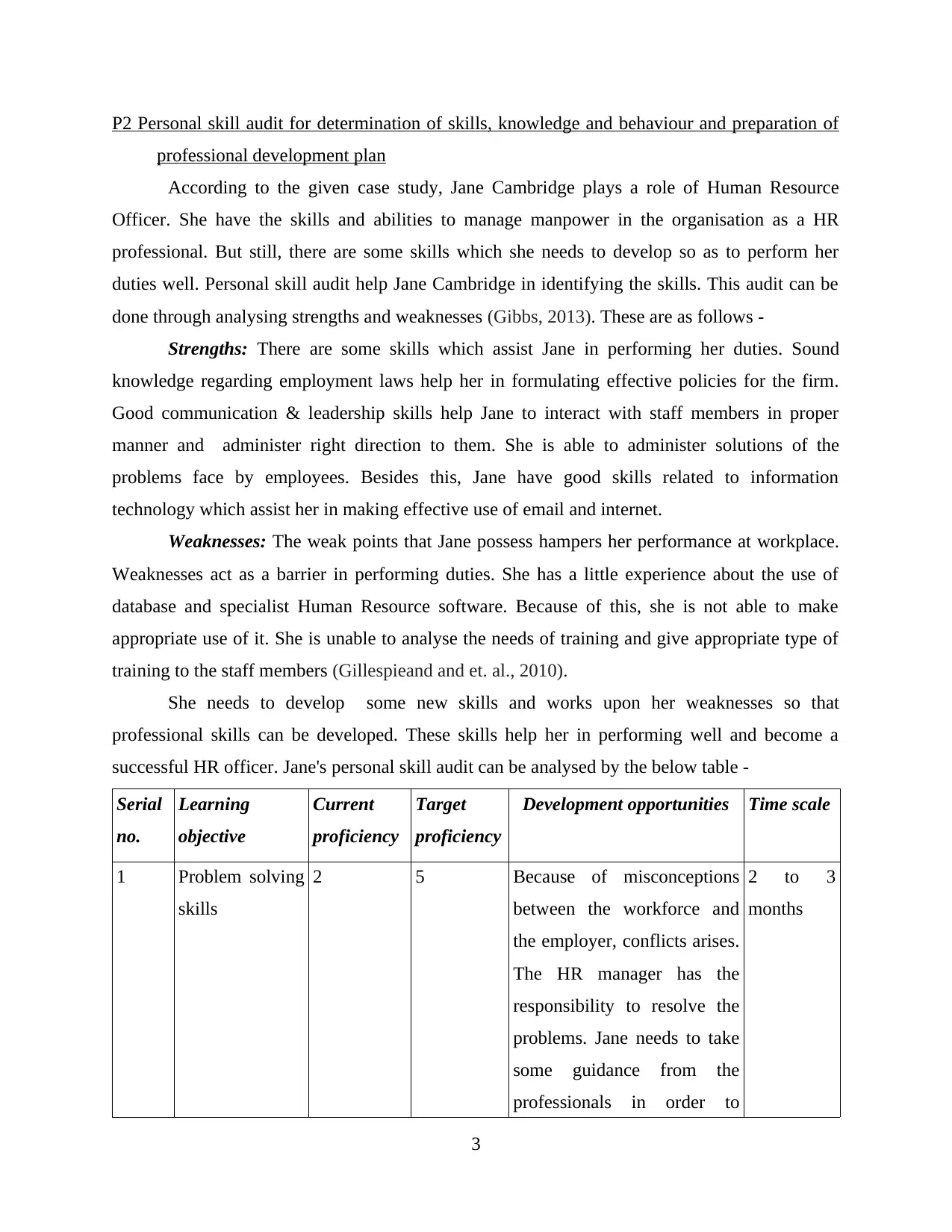
P2 Personal skill audit for determination of skills, knowledge and behaviour and preparation of
professional development plan
According to the given case study, Jane Cambridge plays a role of Human Resource
Officer. She have the skills and abilities to manage manpower in the organisation as a HR
professional. But still, there are some skills which she needs to develop so as to perform her
duties well. Personal skill audit help Jane Cambridge in identifying the skills. This audit can be
done through analysing strengths and weaknesses (Gibbs, 2013). These are as follows -
Strengths: There are some skills which assist Jane in performing her duties. Sound
knowledge regarding employment laws help her in formulating effective policies for the firm.
Good communication & leadership skills help Jane to interact with staff members in proper
manner and administer right direction to them. She is able to administer solutions of the
problems face by employees. Besides this, Jane have good skills related to information
technology which assist her in making effective use of email and internet.
Weaknesses: The weak points that Jane possess hampers her performance at workplace.
Weaknesses act as a barrier in performing duties. She has a little experience about the use of
database and specialist Human Resource software. Because of this, she is not able to make
appropriate use of it. She is unable to analyse the needs of training and give appropriate type of
training to the staff members (Gillespieand and et. al., 2010).
She needs to develop some new skills and works upon her weaknesses so that
professional skills can be developed. These skills help her in performing well and become a
successful HR officer. Jane's personal skill audit can be analysed by the below table -
Serial
no.
Learning
objective
Current
proficiency
Target
proficiency
Development opportunities Time scale
1 Problem solving
skills
2 5 Because of misconceptions
between the workforce and
the employer, conflicts arises.
The HR manager has the
responsibility to resolve the
problems. Jane needs to take
some guidance from the
professionals in order to
2 to 3
months
3
professional development plan
According to the given case study, Jane Cambridge plays a role of Human Resource
Officer. She have the skills and abilities to manage manpower in the organisation as a HR
professional. But still, there are some skills which she needs to develop so as to perform her
duties well. Personal skill audit help Jane Cambridge in identifying the skills. This audit can be
done through analysing strengths and weaknesses (Gibbs, 2013). These are as follows -
Strengths: There are some skills which assist Jane in performing her duties. Sound
knowledge regarding employment laws help her in formulating effective policies for the firm.
Good communication & leadership skills help Jane to interact with staff members in proper
manner and administer right direction to them. She is able to administer solutions of the
problems face by employees. Besides this, Jane have good skills related to information
technology which assist her in making effective use of email and internet.
Weaknesses: The weak points that Jane possess hampers her performance at workplace.
Weaknesses act as a barrier in performing duties. She has a little experience about the use of
database and specialist Human Resource software. Because of this, she is not able to make
appropriate use of it. She is unable to analyse the needs of training and give appropriate type of
training to the staff members (Gillespieand and et. al., 2010).
She needs to develop some new skills and works upon her weaknesses so that
professional skills can be developed. These skills help her in performing well and become a
successful HR officer. Jane's personal skill audit can be analysed by the below table -
Serial
no.
Learning
objective
Current
proficiency
Target
proficiency
Development opportunities Time scale
1 Problem solving
skills
2 5 Because of misconceptions
between the workforce and
the employer, conflicts arises.
The HR manager has the
responsibility to resolve the
problems. Jane needs to take
some guidance from the
professionals in order to
2 to 3
months
3
⊘ This is a preview!⊘
Do you want full access?
Subscribe today to unlock all pages.

Trusted by 1+ million students worldwide
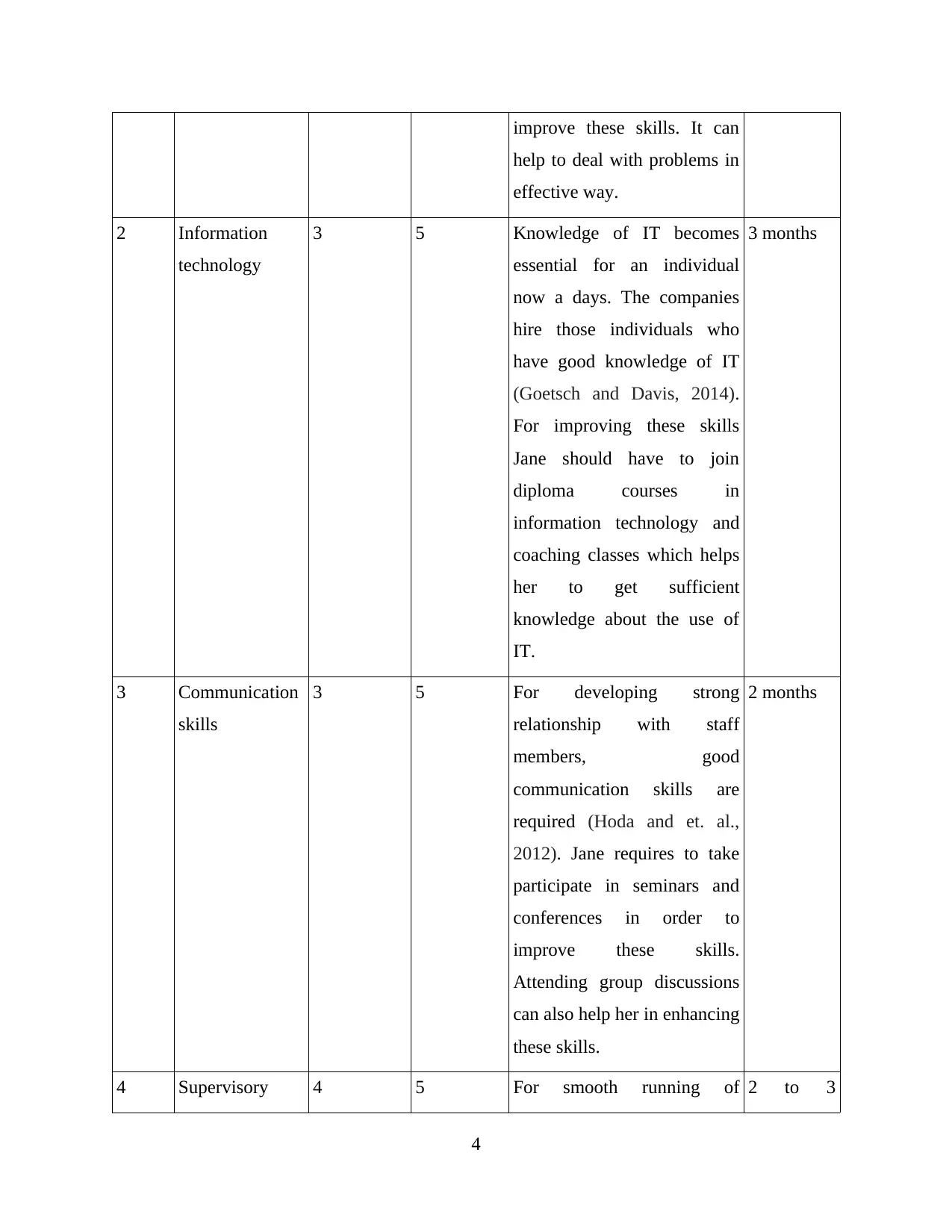
improve these skills. It can
help to deal with problems in
effective way.
2 Information
technology
3 5 Knowledge of IT becomes
essential for an individual
now a days. The companies
hire those individuals who
have good knowledge of IT
(Goetsch and Davis, 2014).
For improving these skills
Jane should have to join
diploma courses in
information technology and
coaching classes which helps
her to get sufficient
knowledge about the use of
IT.
3 months
3 Communication
skills
3 5 For developing strong
relationship with staff
members, good
communication skills are
required (Hoda and et. al.,
2012). Jane requires to take
participate in seminars and
conferences in order to
improve these skills.
Attending group discussions
can also help her in enhancing
these skills.
2 months
4 Supervisory 4 5 For smooth running of 2 to 3
4
help to deal with problems in
effective way.
2 Information
technology
3 5 Knowledge of IT becomes
essential for an individual
now a days. The companies
hire those individuals who
have good knowledge of IT
(Goetsch and Davis, 2014).
For improving these skills
Jane should have to join
diploma courses in
information technology and
coaching classes which helps
her to get sufficient
knowledge about the use of
IT.
3 months
3 Communication
skills
3 5 For developing strong
relationship with staff
members, good
communication skills are
required (Hoda and et. al.,
2012). Jane requires to take
participate in seminars and
conferences in order to
improve these skills.
Attending group discussions
can also help her in enhancing
these skills.
2 months
4 Supervisory 4 5 For smooth running of 2 to 3
4
Paraphrase This Document
Need a fresh take? Get an instant paraphrase of this document with our AI Paraphraser
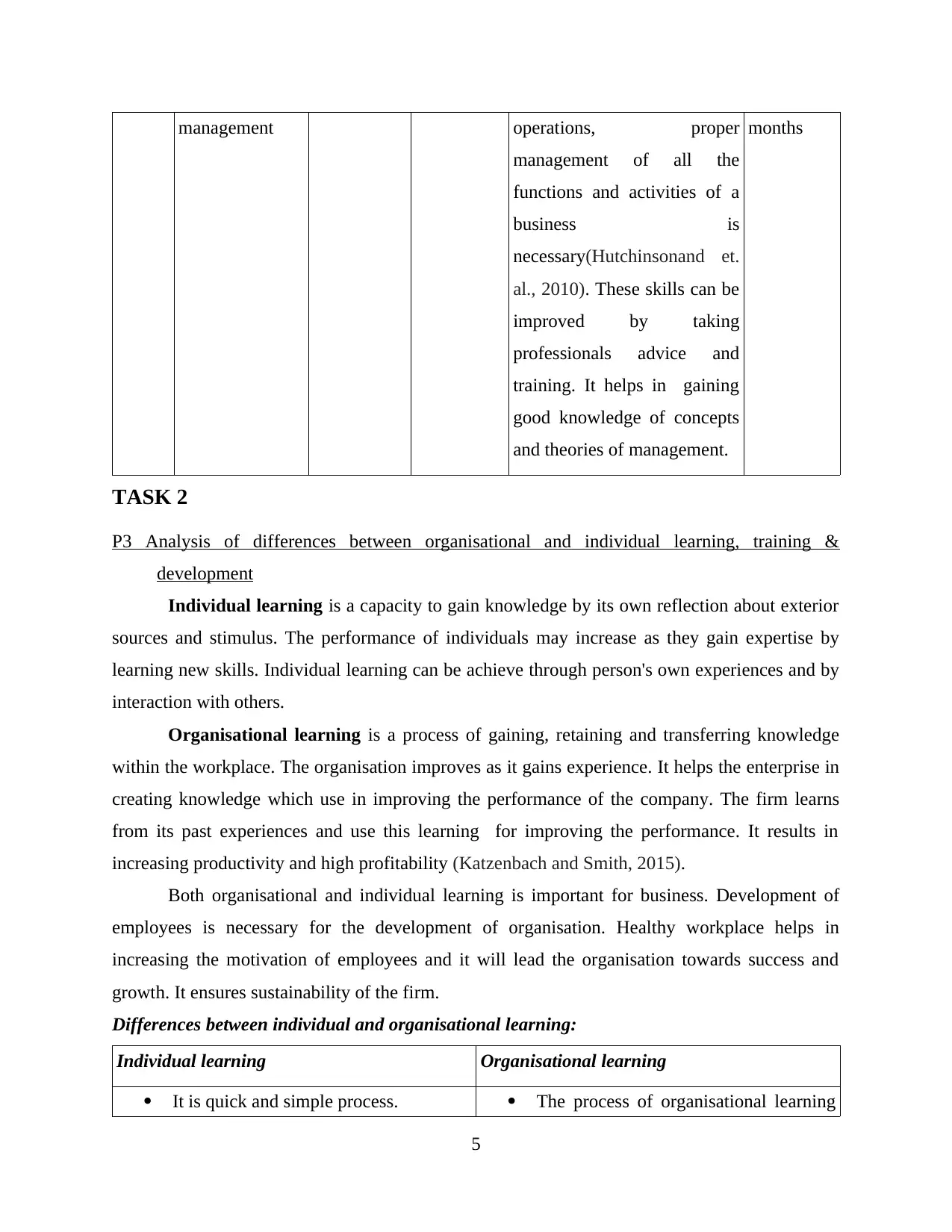
management operations, proper
management of all the
functions and activities of a
business is
necessary(Hutchinsonand et.
al., 2010). These skills can be
improved by taking
professionals advice and
training. It helps in gaining
good knowledge of concepts
and theories of management.
months
TASK 2
P3 Analysis of differences between organisational and individual learning, training &
development
Individual learning is a capacity to gain knowledge by its own reflection about exterior
sources and stimulus. The performance of individuals may increase as they gain expertise by
learning new skills. Individual learning can be achieve through person's own experiences and by
interaction with others.
Organisational learning is a process of gaining, retaining and transferring knowledge
within the workplace. The organisation improves as it gains experience. It helps the enterprise in
creating knowledge which use in improving the performance of the company. The firm learns
from its past experiences and use this learning for improving the performance. It results in
increasing productivity and high profitability (Katzenbach and Smith, 2015).
Both organisational and individual learning is important for business. Development of
employees is necessary for the development of organisation. Healthy workplace helps in
increasing the motivation of employees and it will lead the organisation towards success and
growth. It ensures sustainability of the firm.
Differences between individual and organisational learning:
Individual learning Organisational learning
It is quick and simple process. The process of organisational learning
5
management of all the
functions and activities of a
business is
necessary(Hutchinsonand et.
al., 2010). These skills can be
improved by taking
professionals advice and
training. It helps in gaining
good knowledge of concepts
and theories of management.
months
TASK 2
P3 Analysis of differences between organisational and individual learning, training &
development
Individual learning is a capacity to gain knowledge by its own reflection about exterior
sources and stimulus. The performance of individuals may increase as they gain expertise by
learning new skills. Individual learning can be achieve through person's own experiences and by
interaction with others.
Organisational learning is a process of gaining, retaining and transferring knowledge
within the workplace. The organisation improves as it gains experience. It helps the enterprise in
creating knowledge which use in improving the performance of the company. The firm learns
from its past experiences and use this learning for improving the performance. It results in
increasing productivity and high profitability (Katzenbach and Smith, 2015).
Both organisational and individual learning is important for business. Development of
employees is necessary for the development of organisation. Healthy workplace helps in
increasing the motivation of employees and it will lead the organisation towards success and
growth. It ensures sustainability of the firm.
Differences between individual and organisational learning:
Individual learning Organisational learning
It is quick and simple process. The process of organisational learning
5
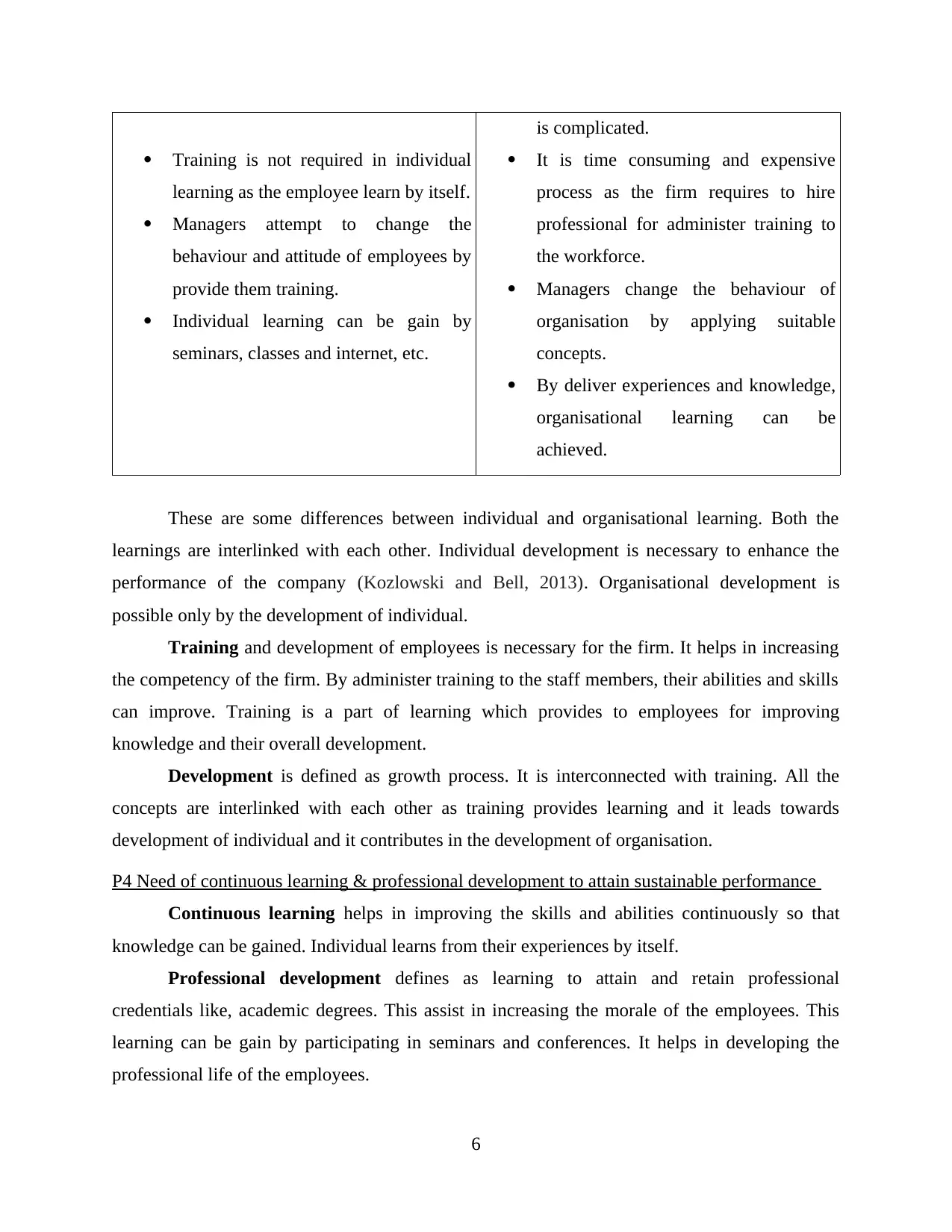
Training is not required in individual
learning as the employee learn by itself.
Managers attempt to change the
behaviour and attitude of employees by
provide them training.
Individual learning can be gain by
seminars, classes and internet, etc.
is complicated.
It is time consuming and expensive
process as the firm requires to hire
professional for administer training to
the workforce.
Managers change the behaviour of
organisation by applying suitable
concepts.
By deliver experiences and knowledge,
organisational learning can be
achieved.
These are some differences between individual and organisational learning. Both the
learnings are interlinked with each other. Individual development is necessary to enhance the
performance of the company (Kozlowski and Bell, 2013). Organisational development is
possible only by the development of individual.
Training and development of employees is necessary for the firm. It helps in increasing
the competency of the firm. By administer training to the staff members, their abilities and skills
can improve. Training is a part of learning which provides to employees for improving
knowledge and their overall development.
Development is defined as growth process. It is interconnected with training. All the
concepts are interlinked with each other as training provides learning and it leads towards
development of individual and it contributes in the development of organisation.
P4 Need of continuous learning & professional development to attain sustainable performance
Continuous learning helps in improving the skills and abilities continuously so that
knowledge can be gained. Individual learns from their experiences by itself.
Professional development defines as learning to attain and retain professional
credentials like, academic degrees. This assist in increasing the morale of the employees. This
learning can be gain by participating in seminars and conferences. It helps in developing the
professional life of the employees.
6
learning as the employee learn by itself.
Managers attempt to change the
behaviour and attitude of employees by
provide them training.
Individual learning can be gain by
seminars, classes and internet, etc.
is complicated.
It is time consuming and expensive
process as the firm requires to hire
professional for administer training to
the workforce.
Managers change the behaviour of
organisation by applying suitable
concepts.
By deliver experiences and knowledge,
organisational learning can be
achieved.
These are some differences between individual and organisational learning. Both the
learnings are interlinked with each other. Individual development is necessary to enhance the
performance of the company (Kozlowski and Bell, 2013). Organisational development is
possible only by the development of individual.
Training and development of employees is necessary for the firm. It helps in increasing
the competency of the firm. By administer training to the staff members, their abilities and skills
can improve. Training is a part of learning which provides to employees for improving
knowledge and their overall development.
Development is defined as growth process. It is interconnected with training. All the
concepts are interlinked with each other as training provides learning and it leads towards
development of individual and it contributes in the development of organisation.
P4 Need of continuous learning & professional development to attain sustainable performance
Continuous learning helps in improving the skills and abilities continuously so that
knowledge can be gained. Individual learns from their experiences by itself.
Professional development defines as learning to attain and retain professional
credentials like, academic degrees. This assist in increasing the morale of the employees. This
learning can be gain by participating in seminars and conferences. It helps in developing the
professional life of the employees.
6
⊘ This is a preview!⊘
Do you want full access?
Subscribe today to unlock all pages.

Trusted by 1+ million students worldwide
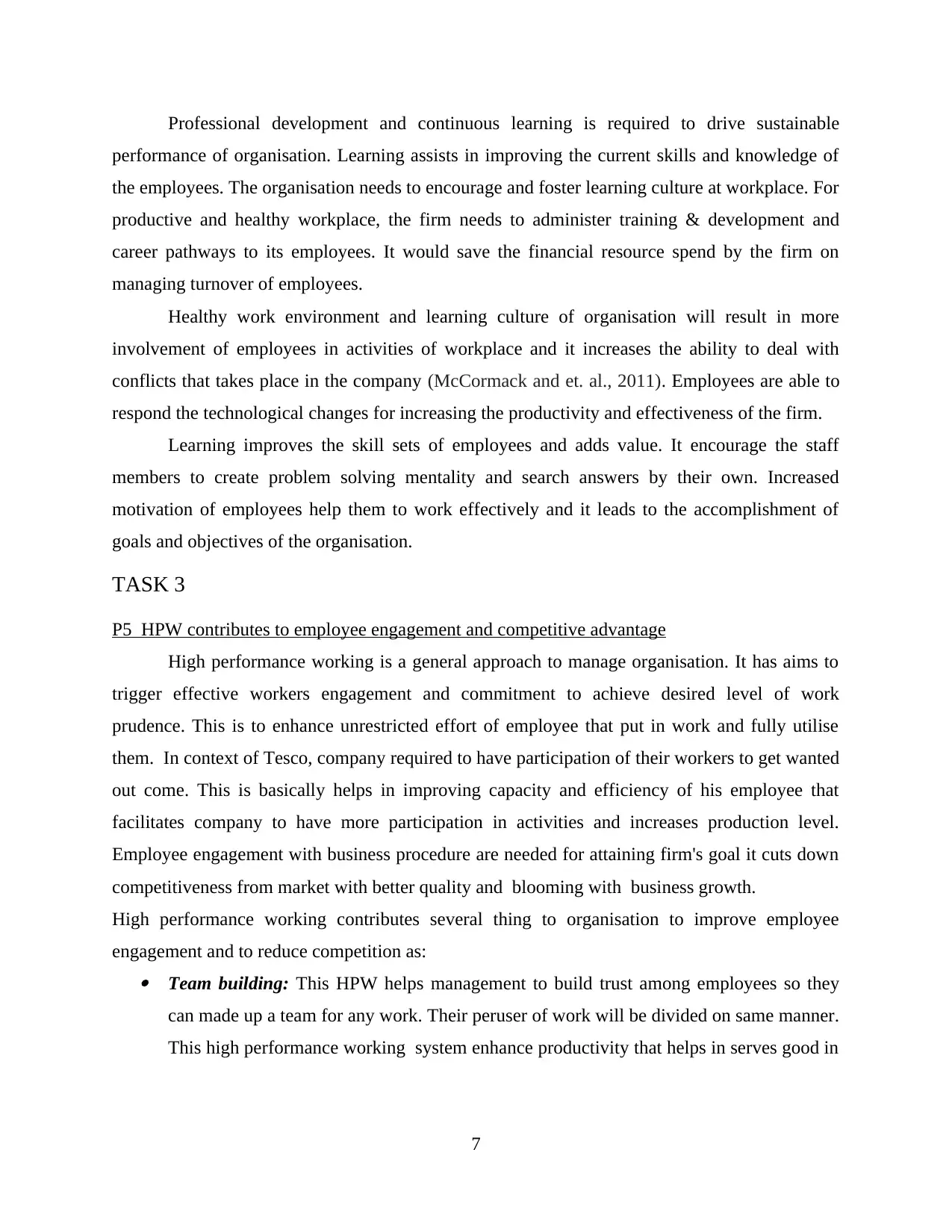
Professional development and continuous learning is required to drive sustainable
performance of organisation. Learning assists in improving the current skills and knowledge of
the employees. The organisation needs to encourage and foster learning culture at workplace. For
productive and healthy workplace, the firm needs to administer training & development and
career pathways to its employees. It would save the financial resource spend by the firm on
managing turnover of employees.
Healthy work environment and learning culture of organisation will result in more
involvement of employees in activities of workplace and it increases the ability to deal with
conflicts that takes place in the company (McCormack and et. al., 2011). Employees are able to
respond the technological changes for increasing the productivity and effectiveness of the firm.
Learning improves the skill sets of employees and adds value. It encourage the staff
members to create problem solving mentality and search answers by their own. Increased
motivation of employees help them to work effectively and it leads to the accomplishment of
goals and objectives of the organisation.
TASK 3
P5 HPW contributes to employee engagement and competitive advantage
High performance working is a general approach to manage organisation. It has aims to
trigger effective workers engagement and commitment to achieve desired level of work
prudence. This is to enhance unrestricted effort of employee that put in work and fully utilise
them. In context of Tesco, company required to have participation of their workers to get wanted
out come. This is basically helps in improving capacity and efficiency of his employee that
facilitates company to have more participation in activities and increases production level.
Employee engagement with business procedure are needed for attaining firm's goal it cuts down
competitiveness from market with better quality and blooming with business growth.
High performance working contributes several thing to organisation to improve employee
engagement and to reduce competition as: Team building: This HPW helps management to build trust among employees so they
can made up a team for any work. Their peruser of work will be divided on same manner.
This high performance working system enhance productivity that helps in serves good in
7
performance of organisation. Learning assists in improving the current skills and knowledge of
the employees. The organisation needs to encourage and foster learning culture at workplace. For
productive and healthy workplace, the firm needs to administer training & development and
career pathways to its employees. It would save the financial resource spend by the firm on
managing turnover of employees.
Healthy work environment and learning culture of organisation will result in more
involvement of employees in activities of workplace and it increases the ability to deal with
conflicts that takes place in the company (McCormack and et. al., 2011). Employees are able to
respond the technological changes for increasing the productivity and effectiveness of the firm.
Learning improves the skill sets of employees and adds value. It encourage the staff
members to create problem solving mentality and search answers by their own. Increased
motivation of employees help them to work effectively and it leads to the accomplishment of
goals and objectives of the organisation.
TASK 3
P5 HPW contributes to employee engagement and competitive advantage
High performance working is a general approach to manage organisation. It has aims to
trigger effective workers engagement and commitment to achieve desired level of work
prudence. This is to enhance unrestricted effort of employee that put in work and fully utilise
them. In context of Tesco, company required to have participation of their workers to get wanted
out come. This is basically helps in improving capacity and efficiency of his employee that
facilitates company to have more participation in activities and increases production level.
Employee engagement with business procedure are needed for attaining firm's goal it cuts down
competitiveness from market with better quality and blooming with business growth.
High performance working contributes several thing to organisation to improve employee
engagement and to reduce competition as: Team building: This HPW helps management to build trust among employees so they
can made up a team for any work. Their peruser of work will be divided on same manner.
This high performance working system enhance productivity that helps in serves good in
7
Paraphrase This Document
Need a fresh take? Get an instant paraphrase of this document with our AI Paraphraser
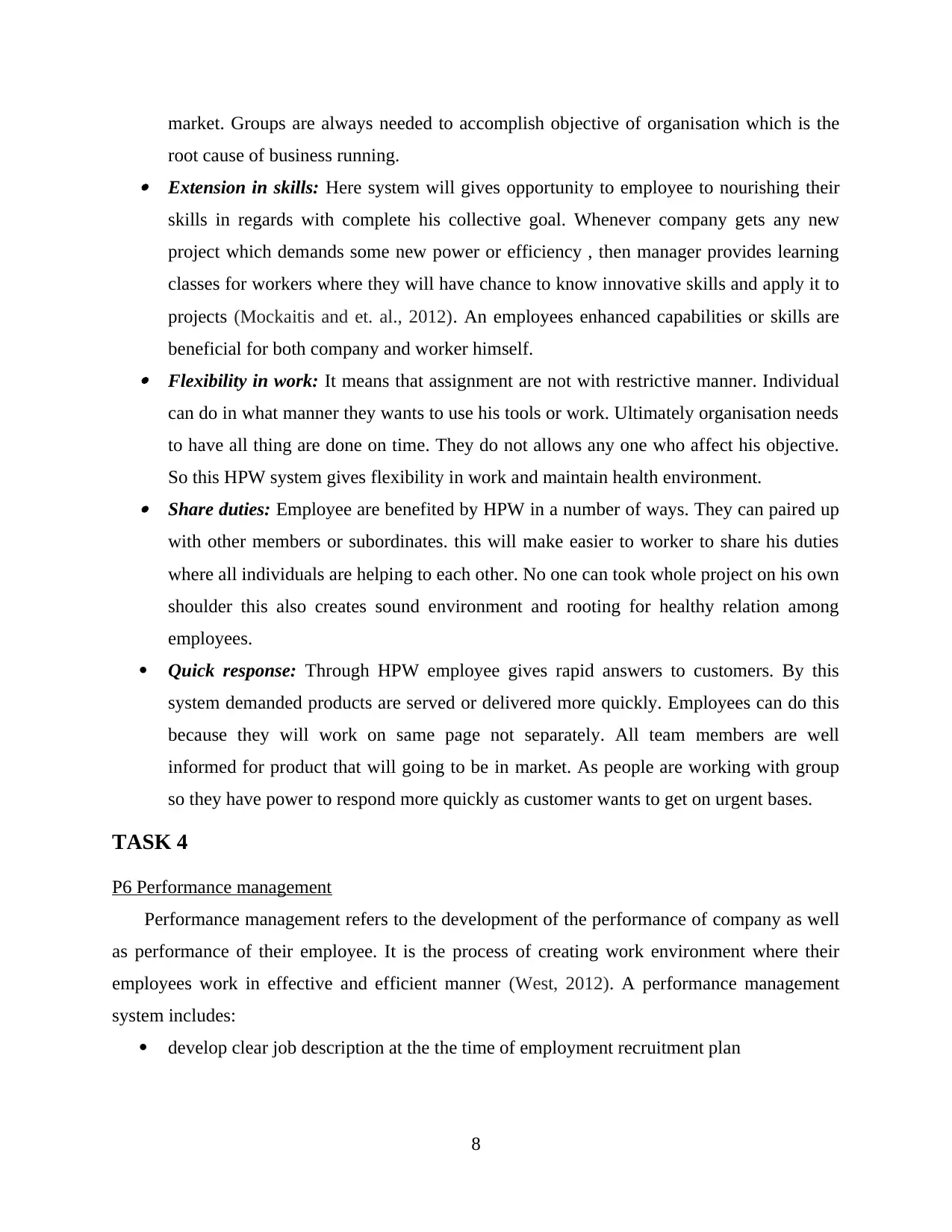
market. Groups are always needed to accomplish objective of organisation which is the
root cause of business running. Extension in skills: Here system will gives opportunity to employee to nourishing their
skills in regards with complete his collective goal. Whenever company gets any new
project which demands some new power or efficiency , then manager provides learning
classes for workers where they will have chance to know innovative skills and apply it to
projects (Mockaitis and et. al., 2012). An employees enhanced capabilities or skills are
beneficial for both company and worker himself. Flexibility in work: It means that assignment are not with restrictive manner. Individual
can do in what manner they wants to use his tools or work. Ultimately organisation needs
to have all thing are done on time. They do not allows any one who affect his objective.
So this HPW system gives flexibility in work and maintain health environment. Share duties: Employee are benefited by HPW in a number of ways. They can paired up
with other members or subordinates. this will make easier to worker to share his duties
where all individuals are helping to each other. No one can took whole project on his own
shoulder this also creates sound environment and rooting for healthy relation among
employees.
Quick response: Through HPW employee gives rapid answers to customers. By this
system demanded products are served or delivered more quickly. Employees can do this
because they will work on same page not separately. All team members are well
informed for product that will going to be in market. As people are working with group
so they have power to respond more quickly as customer wants to get on urgent bases.
TASK 4
P6 Performance management
Performance management refers to the development of the performance of company as well
as performance of their employee. It is the process of creating work environment where their
employees work in effective and efficient manner (West, 2012). A performance management
system includes:
develop clear job description at the the time of employment recruitment plan
8
root cause of business running. Extension in skills: Here system will gives opportunity to employee to nourishing their
skills in regards with complete his collective goal. Whenever company gets any new
project which demands some new power or efficiency , then manager provides learning
classes for workers where they will have chance to know innovative skills and apply it to
projects (Mockaitis and et. al., 2012). An employees enhanced capabilities or skills are
beneficial for both company and worker himself. Flexibility in work: It means that assignment are not with restrictive manner. Individual
can do in what manner they wants to use his tools or work. Ultimately organisation needs
to have all thing are done on time. They do not allows any one who affect his objective.
So this HPW system gives flexibility in work and maintain health environment. Share duties: Employee are benefited by HPW in a number of ways. They can paired up
with other members or subordinates. this will make easier to worker to share his duties
where all individuals are helping to each other. No one can took whole project on his own
shoulder this also creates sound environment and rooting for healthy relation among
employees.
Quick response: Through HPW employee gives rapid answers to customers. By this
system demanded products are served or delivered more quickly. Employees can do this
because they will work on same page not separately. All team members are well
informed for product that will going to be in market. As people are working with group
so they have power to respond more quickly as customer wants to get on urgent bases.
TASK 4
P6 Performance management
Performance management refers to the development of the performance of company as well
as performance of their employee. It is the process of creating work environment where their
employees work in effective and efficient manner (West, 2012). A performance management
system includes:
develop clear job description at the the time of employment recruitment plan
8
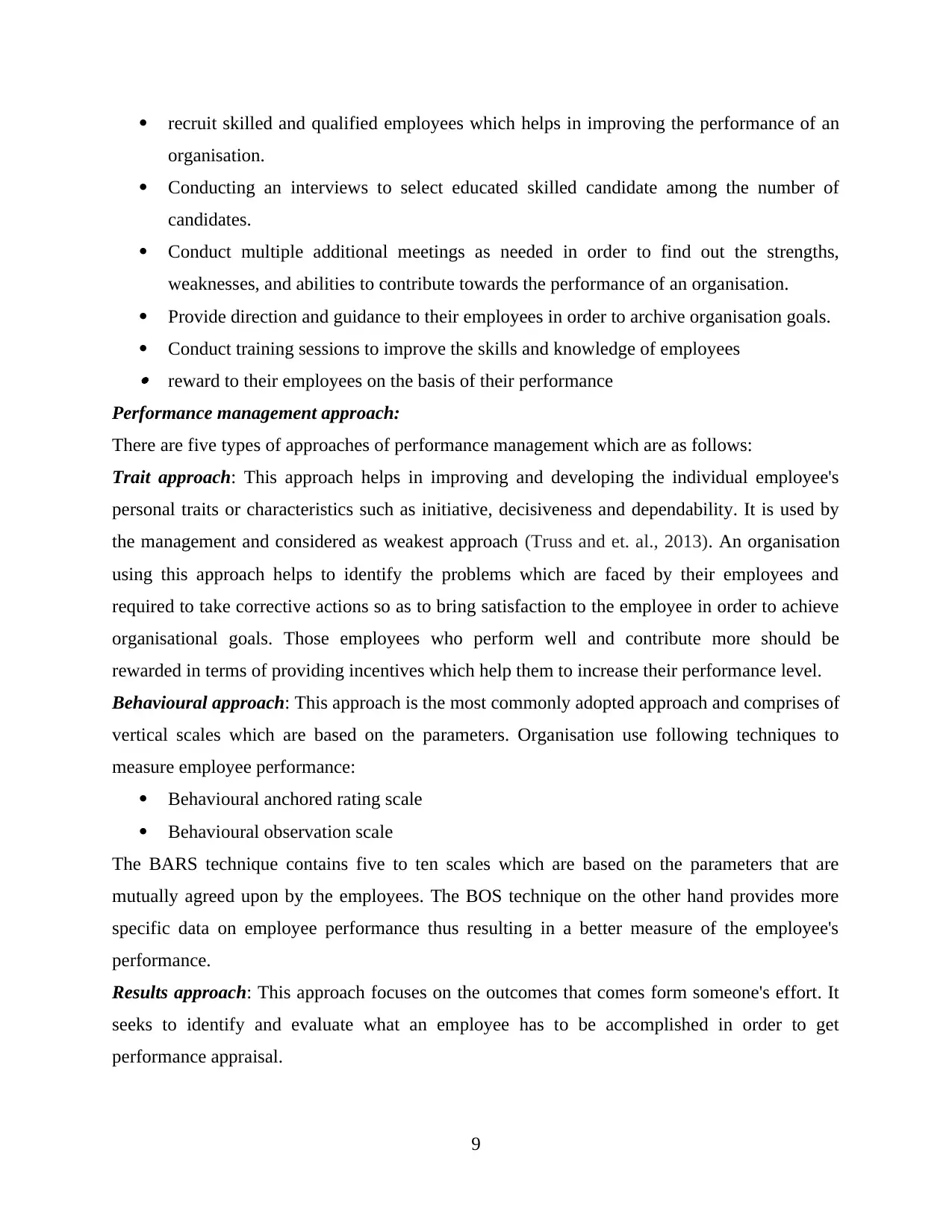
recruit skilled and qualified employees which helps in improving the performance of an
organisation.
Conducting an interviews to select educated skilled candidate among the number of
candidates.
Conduct multiple additional meetings as needed in order to find out the strengths,
weaknesses, and abilities to contribute towards the performance of an organisation.
Provide direction and guidance to their employees in order to archive organisation goals.
Conduct training sessions to improve the skills and knowledge of employees reward to their employees on the basis of their performance
Performance management approach:
There are five types of approaches of performance management which are as follows:
Trait approach: This approach helps in improving and developing the individual employee's
personal traits or characteristics such as initiative, decisiveness and dependability. It is used by
the management and considered as weakest approach (Truss and et. al., 2013). An organisation
using this approach helps to identify the problems which are faced by their employees and
required to take corrective actions so as to bring satisfaction to the employee in order to achieve
organisational goals. Those employees who perform well and contribute more should be
rewarded in terms of providing incentives which help them to increase their performance level.
Behavioural approach: This approach is the most commonly adopted approach and comprises of
vertical scales which are based on the parameters. Organisation use following techniques to
measure employee performance:
Behavioural anchored rating scale
Behavioural observation scale
The BARS technique contains five to ten scales which are based on the parameters that are
mutually agreed upon by the employees. The BOS technique on the other hand provides more
specific data on employee performance thus resulting in a better measure of the employee's
performance.
Results approach: This approach focuses on the outcomes that comes form someone's effort. It
seeks to identify and evaluate what an employee has to be accomplished in order to get
performance appraisal.
9
organisation.
Conducting an interviews to select educated skilled candidate among the number of
candidates.
Conduct multiple additional meetings as needed in order to find out the strengths,
weaknesses, and abilities to contribute towards the performance of an organisation.
Provide direction and guidance to their employees in order to archive organisation goals.
Conduct training sessions to improve the skills and knowledge of employees reward to their employees on the basis of their performance
Performance management approach:
There are five types of approaches of performance management which are as follows:
Trait approach: This approach helps in improving and developing the individual employee's
personal traits or characteristics such as initiative, decisiveness and dependability. It is used by
the management and considered as weakest approach (Truss and et. al., 2013). An organisation
using this approach helps to identify the problems which are faced by their employees and
required to take corrective actions so as to bring satisfaction to the employee in order to achieve
organisational goals. Those employees who perform well and contribute more should be
rewarded in terms of providing incentives which help them to increase their performance level.
Behavioural approach: This approach is the most commonly adopted approach and comprises of
vertical scales which are based on the parameters. Organisation use following techniques to
measure employee performance:
Behavioural anchored rating scale
Behavioural observation scale
The BARS technique contains five to ten scales which are based on the parameters that are
mutually agreed upon by the employees. The BOS technique on the other hand provides more
specific data on employee performance thus resulting in a better measure of the employee's
performance.
Results approach: This approach focuses on the outcomes that comes form someone's effort. It
seeks to identify and evaluate what an employee has to be accomplished in order to get
performance appraisal.
9
⊘ This is a preview!⊘
Do you want full access?
Subscribe today to unlock all pages.

Trusted by 1+ million students worldwide
1 out of 15
Related Documents
Your All-in-One AI-Powered Toolkit for Academic Success.
+13062052269
info@desklib.com
Available 24*7 on WhatsApp / Email
![[object Object]](/_next/static/media/star-bottom.7253800d.svg)
Unlock your academic potential
Copyright © 2020–2025 A2Z Services. All Rights Reserved. Developed and managed by ZUCOL.





